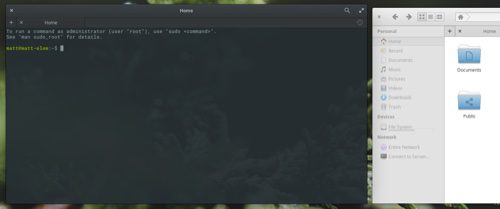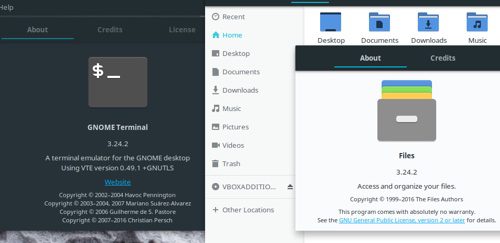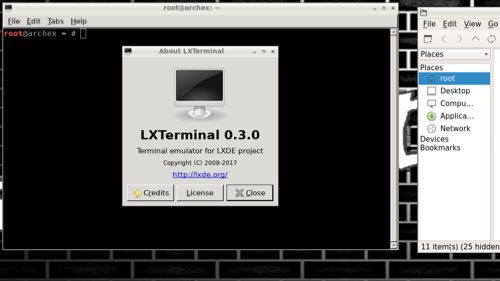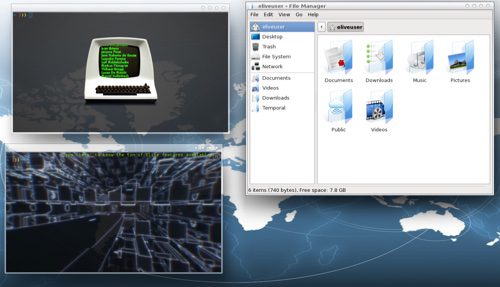Most Linux users have their own desktop environment preference. For example, I enjoy using MATE, where other users I talk with get a lot of value out of XFCE, GNOME or KDE. Yet it surprised me when I asked my Linux using friends what they thought of some of the “newer” Linux desktop environments.
About half of these Linux users have never tried any desktop environment outside of the ones mentioned above. Because of this, I thought it would be interesting to compare the best new Linux desktop environments making a name for themselves.
Pantheon is a comparatively new Linux desktop environment built for the Linux distro known as Elementary. As with any desktop environment, Pantheon isn’t limited to being used on Elementary. It can also be added to other distro that happens to have it available in its repositories.

The Pantheon desktop
Performance: Despite the fact that this feels very modern, speed wasn’t sacrificed here. The App Center, pictures, music and video apps all open instantly on Pantheon when I ran Elementary. Even running Pantheon on another distro, doesn’t lend itself to unneeded bloat. When I click upon Applications, the selection appears instantly. I appreciate this as it means that I’m not waiting for unnecessary lag.
Appearance: Pantheon looks awesome. It feels modern, clean and thanks to the customized applications for pictures, videos, music and so on, you come away with what feels like a cohesive experience. It’s attractive, easy to use and provides a comfortable environment in which to use your computer.
Navigation: Everything about the Pantheon navigation screams logic. Starting from the Applications link, you’re presented with a pull down that makes locating software, settings and more dead simple. You can also choose to go with a list view in the Applications menu. This is useful when you know the category of something you’re looking for, but don’t remember the name of the application. Anything you can’t find from the navigation can be located easily with the Application search box.
Best for visual users: If you are coming from an OS X environment, you’ll find that Pantheon feels very natural. Even coming from another operating system like Windows, Pantheon as a desktop immediately feels cleaner than the default Windows 10 desktop. Note the lack of ads and games no one wants in the menu.
The Budgie desktop environment is provided by the Linux distro team behind Solus. Budgie is also available for other Linux distros, but it shines best with Solus as that’s the overall environment it was designed for.
Performance: Budgie is fast. And when run on the highly optimized Solus Linux distro, it doesn’t disappoint with its speed. Solus is a finely tuned distro that really unleashes the performance provided by Budgie. As one might expect, clicking on the navigation box opens instantly and provides me access to my installed applications and settings. Navigating from one category of software to another is instant and doesn’t lag whatsoever.

The Solus desktop
Appearance: Budgie feels like GNOME, but with GNOME making more sense in terms of layout. It stays out of the way, but also ensures that everything I want to access is a matter of a few mouse clicks away. My biggest impression was made by the notification area. It’s both out of the way and immediately accessible…which is no easy task. I also appreciate that I can access my applets easily yet they’re not flooding my taskbar with icons.
Navigation: Budgie offers its users an attractive, traditional layout. It feels like a blend of old and new, but with user flow always kept in focus with each point of navigation. When I click on the menu to access files and applications, the categories feel familiar to that of other Linux navigation schemes. This is a good thing, and not something that I think needs to change. Also, anything you can’t find from the menu navigation can be searched for with a handy search box.
LXQt isn’t distro specific at all. As a matter of fact, it’s simply a Qt inspired incarnation of the much older desktop LXDE. For my own testing purposes, I’ve been using LXQt in an Arch spun distro called ArchEX.

The LXQt desktop
Performance: When I browse around with LXQt, I immediately feel like I’m running LXDE. I cannot overstate just how similar the two desktop environments are. Even running this on older hardware, everything opens and moves with lightning speed. It’s one thing to be fast, but LXQt provides speed for PCs that might otherwise be too old for other more modern Linux desktop environments like GNOME or KDE.
Appearance: It looks like LXDE and that’s okay. LXDE isn’t pretty, but it does provide you with a fully customizable user experience that can be made to feel more modern. Understanding this, LXQt sticks to LXDE’s mission in keeping things simple looking, but not ugly. By moving into a Qt development space, light weight Linux can once again blossom without needing to depend on the much older LXDE environment. Remember, it’s not which is better – it’s about choices and some individuals prefer working in a Qt based environment.
Navigation: If you’ve ever used GNOME 2, XFCE or LXDE, you’ll feel right at home. Using LXDE based applications such as the terminal or configuration center will feel logically laid out like it did in LXDE. Overall, the benefit to using LXQt is that it is fast and familiar. So don’t expect a completely new experience like with the desktop environments mentioned above.
Enlightenment is a very interesting desktop environment for Linux. For my own testing, I opted to using Enlightenment in a Linux distro called Elive. I’m sure you can install Enlightenment onto other distros as well.
However, I generally recommend using a Linux distro that has it provided as the default option. That way you can avoid any configuration surprises. And yes, Enlightenment is actually quite old…but it’s the current revision of Enlightenment that I feel most people would consider to be quite new.

The Enlightenment desktop
Performance: In terms of speed and performance, I think I’d compare Enlightenment to any well designed modern desktop. Perhaps it’s a little faster than you might expect, given tremendous user experience.
Appearance: Step one is to take everything you would expect from a typical GUI desktop and toss it out the window. That’s Enlightenment in a nutshell. It has the goodness of a traditional desktop environment, but utilizes some pretty advanced theming. For example, you can run with an animated wallpaper. In a fresh installation of the Enlightenment powered Elive distro, the default wallpaper has an animated transition that appears over the wallpaper each time the wallpaper changes.
Navigation: Enlightenment’s navigation is not like most might expect. Basically, you click anywhere on your desktop to bring up your menu options. I find this quite annoying, but can see how it does eliminate the need for a “special” menu button in a dock or on a taskbar.
So does it make sense to drop your existing desktop environment and make the switch to one of those above? Not necessarily, but I do think it’s important to try out new environments and see what’s available.
Speaking for myself personally, I think that older desktop environments tend to be a bit more distro agnostic. Understand, though, that this doesn’t mean you can’t install the newer desktop environments yourself onto an existing distribution. It simply means if there was any fine tuning needed along the way, it’s on you.
Huawei’s AI Update: Things Are Moving Faster Than We Think
FEATURE | By Rob Enderle,
December 04, 2020
Keeping Machine Learning Algorithms Honest in the ‘Ethics-First’ Era
ARTIFICIAL INTELLIGENCE | By Guest Author,
November 18, 2020
Key Trends in Chatbots and RPA
FEATURE | By Guest Author,
November 10, 2020
FEATURE | By Samuel Greengard,
November 05, 2020
ARTIFICIAL INTELLIGENCE | By Guest Author,
November 02, 2020
How Intel’s Work With Autonomous Cars Could Redefine General Purpose AI
ARTIFICIAL INTELLIGENCE | By Rob Enderle,
October 29, 2020
Dell Technologies World: Weaving Together Human And Machine Interaction For AI And Robotics
ARTIFICIAL INTELLIGENCE | By Rob Enderle,
October 23, 2020
The Super Moderator, or How IBM Project Debater Could Save Social Media
FEATURE | By Rob Enderle,
October 16, 2020
FEATURE | By Cynthia Harvey,
October 07, 2020
ARTIFICIAL INTELLIGENCE | By Guest Author,
October 05, 2020
CIOs Discuss the Promise of AI and Data Science
FEATURE | By Guest Author,
September 25, 2020
Microsoft Is Building An AI Product That Could Predict The Future
FEATURE | By Rob Enderle,
September 25, 2020
Top 10 Machine Learning Companies 2020
FEATURE | By Cynthia Harvey,
September 22, 2020
NVIDIA and ARM: Massively Changing The AI Landscape
ARTIFICIAL INTELLIGENCE | By Rob Enderle,
September 18, 2020
Continuous Intelligence: Expert Discussion [Video and Podcast]
ARTIFICIAL INTELLIGENCE | By James Maguire,
September 14, 2020
Artificial Intelligence: Governance and Ethics [Video]
ARTIFICIAL INTELLIGENCE | By James Maguire,
September 13, 2020
IBM Watson At The US Open: Showcasing The Power Of A Mature Enterprise-Class AI
FEATURE | By Rob Enderle,
September 11, 2020
Artificial Intelligence: Perception vs. Reality
FEATURE | By James Maguire,
September 09, 2020
Anticipating The Coming Wave Of AI Enhanced PCs
FEATURE | By Rob Enderle,
September 05, 2020
The Critical Nature Of IBM’s NLP (Natural Language Processing) Effort
ARTIFICIAL INTELLIGENCE | By Rob Enderle,
August 14, 2020

Datamation is the leading industry resource for B2B data professionals and technology buyers. Datamation's focus is on providing insight into the latest trends and innovation in AI, data security, big data, and more, along with in-depth product recommendations and comparisons. More than 1.7M users gain insight and guidance from Datamation every year.
Advertise with TechnologyAdvice on Datamation and our other data and technology-focused platforms.
Advertise with Us
Property of TechnologyAdvice.
© 2025 TechnologyAdvice. All Rights Reserved
Advertiser Disclosure: Some of the products that appear on this
site are from companies from which TechnologyAdvice receives
compensation. This compensation may impact how and where products
appear on this site including, for example, the order in which
they appear. TechnologyAdvice does not include all companies
or all types of products available in the marketplace.